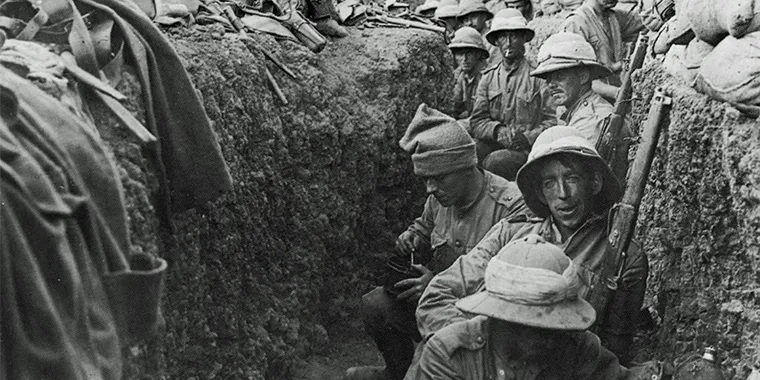There ere light battles and few casualties D. The fighting was bloody and little was gained.

Blood And Mud A French Soldier S Wwi Memoir Vividly Describes Trench Warfare
A time of heavy fighting c.

. World War 1 only lasted for four years but public mood and expectation over the conflict changed dramatically during that time. When war broke out in 1914 public expectations were high that it. During what war did the Christmas Truce take place.
The Gorlice attack was launched and the Russians were routed. World War I was just a war to see which countries were the best and. World War II b.
Test your knowledge on all of World War I 19141919. Which best describes fighting on the Eastern and Western Fronts during World War I. A France B Great Britain C Russia D Bulgaria.
The Western Front was a defensive stalemate from 1914-1918 while the Eastern Front was much more fluid The armistice on the Western Front of World War I was signed on which date. At the Second Battle of Ypres the Germans used chlorine gas for the first time on the Western Front. All of the above e.
World War 1 began because a Serbian guy shot an important Austrian guy and Austria blamed Serbia so they sent them a big long list of demandsone of which was unreasonable so Austria-Hungary attacked Serbia who was backed by Russia who was backed by France who disliked Germany after they took Alsace-LorraineElsass-Lothringen in the Franco-Prussian war and. The plan called for the creation of a single Arab state in the mandate. What was a Progressive goal.
An unofficial agreement to not fight between the soldiers d. Which statement best describes the fighting during the first two years of World War I. An official cease fire between the two countries b.
Quick attacks with coordinated aircraft artillery and infantry. Which of the following best describes the Christmas Truce. Which of the following statements best describes the opening years of fighting in World War I.
Naval battles between ships fighting over trade routes. None of the above 2. The war favored offensive tactics C.
What nation did Austria-Hungary and Germany fight on the Eastern Front during World War I. The fighting was bloody and little was gained. Which statement best describes the United Nations plan for the Palestine Mandate after World War II.
The plan called for the creation of a single Jewish state in the mandate. Both sides gained and lost a a lot of ground during battles B. German forces defeated the Russians at Tannenberg in the first major battle then attacked France through Belgium Luxembourg and Alsace-Lorraine but became locked in a stalemate with Allied forces on the Western Front.
The nature of warfare during World War One on the Western and Eastern Fronts can best be described as. Which of the following best describes warfare during World War I. What countries fought in the Western Front.
What best describes the fighting in world war i. World War 1was fought in trenches or deep slits in theground. What best describes the fighting in World War 1.
Perfect prep for World War I 19141919 quizzes and tests you might have in school. A guerrilla warfare B trench warfare C nuclear warfare D. Which best describes fighting on the Eastern and Western Fronts during World War I.
The Western Front was a defensive stalemate from 1914-1918 while the Eastern Front was much more fluid. Which best describes fighting on the Eastern and Western Fronts during World War I. What term best describes the fighting along the Western Front during World War I.
The plan called for the creation of two states one Arab. What best describes the fighting in world war one. The Western Front was mired in trench warfare.
A Naval battles between ships fighting over trade routes B Quick attacks with coordinated aircraft artillery and infantry C Guerrilla combatants attacking from behind trees and in cities D Soldiers digging in trenches and coming out over the top to attack. Which of the following best describes warfare during World War I. A nuclear warfare B trench warfare C guerilla warfare D.
The technology used in the Eastern Front was more advanced than that used in the Western Front. A The war was dynamic and ever-changing as the balance of power swung between the Allied Powers and the Central Powers. What term best describes the fighting along the Western Front during World War I.
What nation did the Allied Powers with the exception of the United States blame for World War I. Both sides gained and lost a a lot of ground during battles B. The war favored offensive tactics C.
What best describes the fighting in world war one. Answer choices a series of swift and decisive battles. There ere light battles and few casualties D.
The plan called for continued British control of the mandate. Eventually the Russians retreated along a line that ran from the Baltic Sea to the Romanian border. Which of these was a characteristic of the changing culture at the end of the 19th sentury.
Which statement best describes a relationship between World War I and the Bolshevik Revolution. Choose 1 AThey were both characterized by trench warfare that gave the advantage to the defense BThe Western Front was a defensive stalemate from 1914-1918 while the Eastern Front was much more fluid.

Life In The Trenches Of World War I History


0 Comments